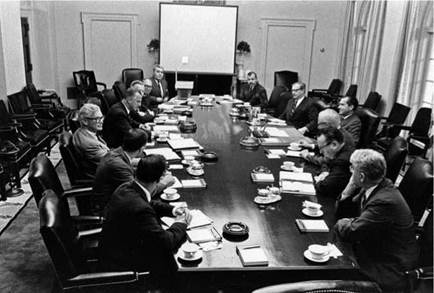Space Task Group Reports to the President
At 3:00 p. m. on September 15, President Richard Nixon met in the White House Cabinet Room with the members of the STG (with the exception of Glenn Seaborg, who was out of Washington). In transmitting the STG report to the president, Vice President Spiro Agnew commented that “the three options presented in the report provide properly balanced space programs, and that the range of choice provides flexibility in meeting budgetary constraints.” Agnew suggested that Nixon choose Option II of the STG report, noting that “the cornerstones for any of the program options are two projects—the space station and the space transportation system.”51
As planned, Russ Drew summarized the report and its recommendations. President Nixon responded that “he felt strongly that the Nation should move forward in space,” and that “while the present financial burdens of the country may limit how fast we were able to move at this time, he wanted to be in a position to move faster in the future if circumstances permit.” Nixon “tended to focus on the manned planetary mission” and welcomed the flexibility in the STG options to decide “in a couple of years” whether to undertake a mission to Mars in 1983. The president “liked the approach of the report. He was pleased that it rejected any substantial reduction in space activities and, at the other extreme, did not propose a crash program for a manned Mars landing.” At the conclusion of the meeting President Nixon “stated a very positive personal view with respect to moving ahead” with U. S. space activities.52
The STG report and the NASA input to the STG, “America’s Next Decades in Space,” were released at a September 17 White House press conference attended by Agnew, DuBridge, Seamans, and Paine. Agnew made public his transmittal letter to President Nixon in which he had recommended
|
The Space Task Group presents its report to President Nixon on September 15, 1969. Clockwise from top right: Russell Drew, Office of Science and Technology; Thomas Paine, NASA; the President; Science Adviser Lee DuBridge; Budget Director Robert Mayo; Presidential Counselor Arthur Burns; (with back to camera) Milton Klein, Atomic Energy Commission; Bill Anders, National Aeronautics and Space Council; Robert Seamans, Secretary of the Air Force; Vice-President Spiro Agnew; Undersecretary of State U. Alexis Johnson; Jerome Wolff, Office of the Vice President; Frank Pagnotta, Office of Science and Technology. (Photograph WHPO 1962-4, courtesy of the Richard Nixon Presidential Library & Museum) |
Option II. Seamans and DuBridge chose not to go on the public record with respect to their recommendation to the president, and Paine said he had not yet made his recommendation; he did so in a letter to the president on September 19. Like the vice president, Paine in his letter recommended that Nixon select Option II, “a balanced and challenging program.” Ever the optimist, Paine added, “as the nation progresses toward meeting its other needs during the next few years, I would hope that we might be able to reexamine this and move closer to Option I.”53











